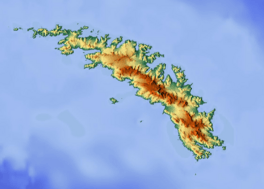Hindle Glacier facts for kids
Quick facts for kids Hindle Glacier |
|
|---|---|
| Location | South Georgia |
| Coordinates | 54°34′S 36°5′W / 54.567°S 36.083°W |
| Length | 6 nmi (11 km; 7 mi) |
| Thickness | unknown |
| Terminus | Royal Bay |
| Status | unknown |
Hindle Glacier (54°34′S 36°5′W / 54.567°S 36.083°W) is a large, slow-moving river of ice, also known as a glacier. It stretches about 6 miles (10 km) long. This icy giant flows north from an area near Mount Paterson and ends in Royal Bay. Both Mount Paterson and Royal Bay are found on the northern coast of South Georgia, a remote island in the southern Atlantic Ocean.
Contents
Where is Hindle Glacier?
Hindle Glacier is located on the island of South Georgia. This island is part of a group of islands known as South Georgia and the South Sandwich Islands. It is a very cold place, close to Antarctica. The glacier's exact location is at 54 degrees 34 minutes South and 36 degrees 5 minutes West.
South Georgia Island
South Georgia is a rugged and mountainous island. It is mostly covered in glaciers and snow. The island is home to lots of wildlife, including penguins, seals, and seabirds. It is a very important place for scientific research because of its unique environment.
How did Hindle Glacier get its name?
The glacier was carefully explored and mapped by a group called the South Georgia Survey (SGS) between 1951 and 1952. For a short time, another group, the British South Georgia Expedition (1954–55), unofficially called it "Bruce Glacier." However, there were already many places in the Antarctic named after Dr. William Speirs Bruce, a famous explorer.
Naming Decisions
To avoid confusion, the UK Antarctic Place-Names Committee decided in 1957 to give the glacier a new, official name. They chose to name it after Dr. Edward Hindle. Dr. Hindle was a British scientist who studied animals (a zoologist). He was very helpful to the SGS expeditions because he was the Honorary Secretary of the Royal Geographical Society, a famous group that supports exploration and scientific discovery.
Exploring the Glacier
The South Georgia Survey (SGS) played a big role in mapping and understanding Hindle Glacier. Their work involved detailed studies of the glacier's size, shape, and how it moves. Exploring glaciers in places like South Georgia is very challenging due to the extreme cold, strong winds, and difficult terrain. Scientists and explorers use special equipment and skills to navigate these icy landscapes safely.


